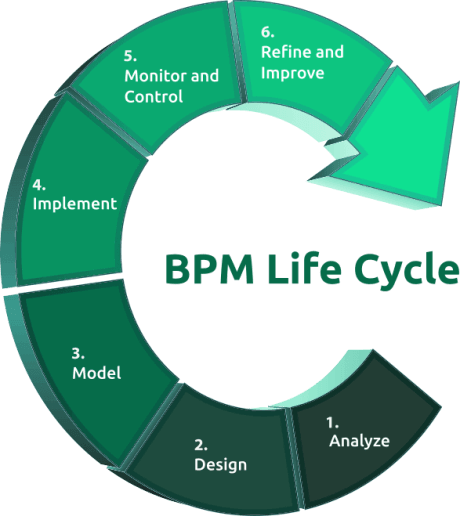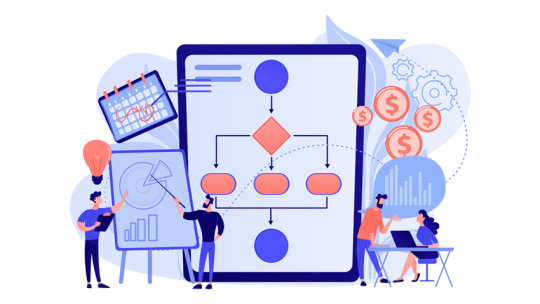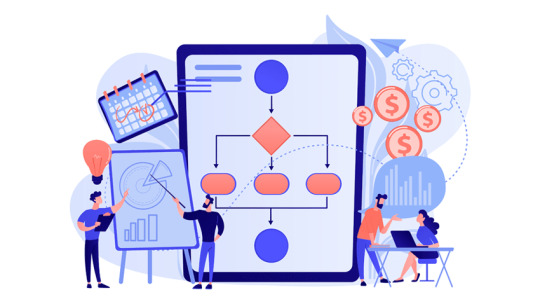Text
Visio Business Process Mapping: Streamlining Your Workflows
In today's fast-paced business environment, efficiency is everything. To stay ahead of the competition, you need to be able to identify areas for improvement in your processes and streamline them. This is where Visio business process mapping comes in handy. Visio is a powerful tool that enables you to map out your business processes visually, making it easy to identify bottlenecks, redundancies, and other inefficiencies.
What is Visio Business Process Mapping?
Visio business process mapping is the process of creating diagrams that show the steps involved in a particular business process. These diagrams can be used to identify areas for improvement, as well as to train employees on how to perform specific tasks. Visio is a popular tool for creating these diagrams because it is easy to use and offers a wide range of templates and shapes that can be customized to fit your specific needs.

Why Use Visio for Business Process Mapping?
There are several reasons why Visio is an excellent tool for business process mapping. First, it allows you to create detailed diagrams that are easy to understand. This can be particularly useful when you are trying to communicate complex processes to others, such as new employees or stakeholders. Second, Visio is flexible, allowing you to customize your diagrams to fit your specific needs. Finally, Visio integrates with other Microsoft tools, such as Excel and PowerPoint, making it easy to share your diagrams with others.
Creating a Visio Business Process Map
To create a Visio business process map, start by identifying the process you want to map out. This could be anything from a customer service process to a manufacturing process. Next, identify the steps involved in the process, and begin to create a diagram that shows how these steps are connected.
When creating your diagram, it is important to use the right shapes and symbols to represent different parts of the process. For example, you might use a rectangle to represent a task, a diamond to represent a decision point, and a circle to represent the start or end of the process.
Once you have created your diagram, it is important to test it out to ensure that it accurately reflects the process you are mapping. You can do this by walking through the process yourself or by having someone else walk through it while you observe.
Benefits of Visio Business Process Mapping
Visio business process mapping offers a wide range of benefits, including:
Improved efficiency: By identifying areas for improvement in your processes, you can streamline workflows and reduce costs.
Enhanced communication: Visio diagrams are easy to understand and can be used to communicate complex processes to others.
Better training: Visio diagrams can be used to train employees on how to perform specific tasks, reducing errors and improving quality.
Increased productivity: By streamlining your processes, you can free up time and resources to focus on other areas of your business.
Conclusion
Visio business process mapping is a powerful tool that can help you identify areas for improvement in your workflows. By creating detailed diagrams of your processes, you can streamline workflows, reduce costs, and improve communication and training. If you haven't already, consider incorporating Visio into your business process mapping efforts.
youtube
Also Read : business process mapping efforts
SITES WE SUPPORT
Business Process Mapping - Wix
SOCIAL LINKS
Facebook
Twitter
LinkedIn
Instagram
YouTube
0 notes
Text
Types of Business Process Management System
Business Process Management Systems (BPMS) are a suite of software tools that enable organizations to manage their business processes in a more efficient and effective manner. A BPMS typically includes workflow management, document management, and reporting capabilities, among other features. In this blog, we will discuss the types of BPMS that are commonly used by organizations.

Integration-Centric BPMS Integration-Centric BPMS is a system that focuses on integrating multiple applications and systems to streamline business processes. It enables organizations to connect different systems, such as CRM, ERP, and HR, to ensure seamless flow of data and reduce redundancy. Integration-Centric BPMS enables organizations to automate and optimize their end-to-end processes.
Human-Centric BPMS Human-Centric BPMS focuses on the human aspect of business processes. It is designed to provide end-users with an intuitive and easy-to-use interface to manage their tasks and workflows. Human-Centric BPMS empowers employees to collaborate more effectively, communicate better, and manage their workload more efficiently.
Document-Centric BPMS Document-Centric BPMS is a system that focuses on managing documents and files associated with business processes. It enables organizations to manage documents throughout their lifecycle, from creation to archiving. Document-Centric BPMS ensures that documents are easily accessible, searchable, and secure.
Rule-Based BPMS Rule-Based BPMS is a system that focuses on automating business rules and decision-making processes. It enables organizations to define and execute complex rules that govern their business processes. Rule-Based BPMS ensures consistency, accuracy, and compliance with regulations and policies.
Analytics-Centric BPMS Analytics-Centric BPMS is a system that focuses on analyzing data generated by business processes. It enables organizations to monitor and measure the performance of their business processes in real-time. Analytics-Centric BPMS provides organizations with insights into process bottlenecks, inefficiencies, and opportunities for improvement.
In conclusion, BPMS is a suite of software tools that enable organizations to manage their business processes more efficiently and effectively. Integration-Centric, Human-Centric, Document-Centric, Rule-Based, and Analytics-Centric BPMS are some of the commonly used types of BPMS. Organizations can choose the type of BPMS that best suits their business needs and goals.
youtube
Also Read : Analytics-Centric BPMS
SITES WE SUPPORT
Business Process Mapping - Wix
SOCIAL LINKS
Facebook
Twitter
LinkedIn
Instagram
YouTube
0 notes
Text
Business Process Modeling Notation: An Overview
Business Process Modeling Notation (BPMN) is a graphical notation used to represent business processes in a clear and standardized manner. BPMN diagrams are widely used to illustrate complex workflows, process architectures, and business procedures in various industries. This blog post will provide an overview of BPMN, its key components, and how it is used in modern business environments.

Key Components of BPMN
BPMN diagrams consist of several key components, including:
Flow objects: These objects represent the various steps and activities within a process. Examples include events, activities, and gateways.
Connecting objects: These objects show how flow objects are related to one another. Examples include sequence flows, message flows, and associations.
Swimlanes: These are used to group related activities or actors within a process. Examples include pools and lanes.
Artifacts: These are used to add additional information to a BPMN diagram. Examples include data objects, annotations, and groups.
Benefits of BPMN
BPMN offers several benefits for organizations, including:
Standardization: BPMN provides a standardized notation for representing business processes, which promotes consistency and clarity across different departments and organizations.
Transparency: BPMN diagrams are easy to understand and can be used to illustrate complex processes in a clear and concise manner. This helps to promote transparency and accountability within an organization.
Collaboration: BPMN can be used to facilitate collaboration and communication between different stakeholders within an organization. By providing a shared language for discussing processes, BPMN helps to promote alignment and understanding.
Analysis: BPMN diagrams can be used to analyze and optimize business processes, identifying areas for improvement and potential bottlenecks.
Uses of BPMN
BPMN is used in a variety of ways within modern business environments, including:
Process design and documentation: BPMN is commonly used to design and document business processes, ensuring that they are clearly defined and easy to understand.
Process optimization: BPMN diagrams can be used to identify areas for process optimization, helping organizations to streamline their operations and improve efficiency.
Process automation: BPMN can be used to automate business processes, reducing the need for manual intervention and improving accuracy and consistency.
Compliance: BPMN can be used to document and demonstrate compliance with regulatory requirements and industry standards.
Conclusion
In conclusion, BPMN is a powerful tool for representing and analyzing business processes. By providing a standardized notation, promoting transparency and collaboration, and facilitating process optimization and automation, BPMN can help organizations to improve their operations and achieve their business goals. Whether you are designing new processes or optimizing existing ones, BPMN is a valuable tool for any modern business environment.
youtube
Also Read : Process design and documentation
SITES WE SUPPORT
Business Process Mapping - Wix
SOCIAL LINKS
Facebook
Twitter
LinkedIn
Instagram
YouTube
0 notes
Text
Features of business process mapping tools
Business process mapping is the practice of visualizing the various steps and stages of a process to identify areas for improvement and streamline operations. There are many different tools available to help businesses map their processes, and each has its own unique set of features and capabilities. In this blog post, we will take a closer look at some of the most popular business process mapping tools available today.

Flowcharts Flowcharts are a popular tool for mapping out business processes. They use symbols and shapes to represent each step in the process, and arrows to show the flow of information or materials between each step. Flowcharts are easy to understand and can be used to identify potential bottlenecks or areas for improvement in a process.
Swimlane diagrams Swimlane diagrams are similar to flowcharts, but they include additional information about who is responsible for each step in the process. Each "swimlane" represents a different department or individual, making it easy to see where handoffs occur and who is responsible for each task.
Value stream maps Value stream maps are a more detailed tool for mapping out business processes. They show the flow of materials and information through the entire process, from start to finish. Value stream maps can help businesses identify areas where they can reduce waste and improve efficiency.
Business process modeling notation (BPMN) BPMN is a standardized notation for modeling business processes. It uses a set of symbols and shapes to represent different types of tasks and events, making it easy to create detailed process maps. BPMN can be used to create complex process models, including those with decision points and loops.
Process simulation Process simulation tools allow businesses to test out different process scenarios before implementing them in real life. This can help businesses identify potential problems or inefficiencies before they occur, saving time and money in the long run.
Process mining Process mining tools analyze data from various systems to create a detailed map of a business process. This can help businesses identify bottlenecks and areas for improvement, as well as track the effectiveness of process changes over time.
In conclusion, business process mapping is an essential practice for businesses looking to improve efficiency and streamline operations. There are many different tools available for mapping out processes, each with its own unique features and capabilities. By choosing the right tool for their specific needs, businesses can gain valuable insights into their processes and identify areas for improvement.
youtube
Also Read : Process simulation tools
SITES WE SUPPORT
Business Process Mapping - Wix
SOCIAL LINKS
Facebook
Twitter
LinkedIn
Instagram
YouTube
0 notes
Text
Phases of Business Process Management System
Business Process Management (BPM) is a methodology used by organizations to optimize their operations, streamline their workflows, and enhance their efficiency. BPM involves analyzing, designing, implementing, monitoring, and optimizing business processes to achieve specific goals. The following are the phases of a Business Process Management System.

Analysis Phase The analysis phase is the first step in any BPM initiative. In this phase, the organization identifies its goals, objectives, and performance metrics. It is important to understand the current processes and identify the areas that need improvement. Organizations can use various tools such as process maps, flowcharts, and diagrams to understand the processes better. The analysis phase helps organizations to identify the gaps between the current state and the desired state.
Design Phase The design phase involves the creation of a new process that aligns with the organization's goals and objectives. The design phase includes the development of process maps, process flows, and process models. The design phase is critical as it sets the foundation for the implementation phase. The design phase also involves the identification of the roles and responsibilities of the people involved in the process.
Implementation Phase The implementation phase involves the execution of the new process. The implementation phase includes the creation of standard operating procedures, training materials, and communication plans. It is important to involve all the stakeholders in the implementation phase to ensure that the process is executed as designed. The implementation phase also involves testing the new process to identify any gaps or issues.
Monitoring Phase The monitoring phase involves tracking the performance of the new process. It is important to measure the performance metrics identified in the analysis phase to determine the success of the new process. The monitoring phase involves the use of various tools such as dashboards, scorecards, and reports. The monitoring phase helps organizations to identify any issues or areas that require improvement.
Optimization Phase The optimization phase involves making improvements to the new process based on the feedback received during the monitoring phase. The optimization phase includes identifying the root cause of any issues and making changes to the process to address them. The optimization phase is critical as it ensures that the process is continuously improved to achieve the desired results.
In conclusion, implementing a Business Process Management System can help organizations to achieve their goals, streamline their workflows, and enhance their efficiency. The phases of a Business Process Management System are analysis, design, implementation, monitoring, and optimization. Each phase is critical in ensuring that the new process is executed successfully and continuously improved to achieve the desired results.
youtube
Also Read : development of process maps
SITES WE SUPPORT
Business Process Mapping - Wix
SOCIAL LINKS
Facebook
Twitter
LinkedIn
Instagram
YouTube
1 note
·
View note